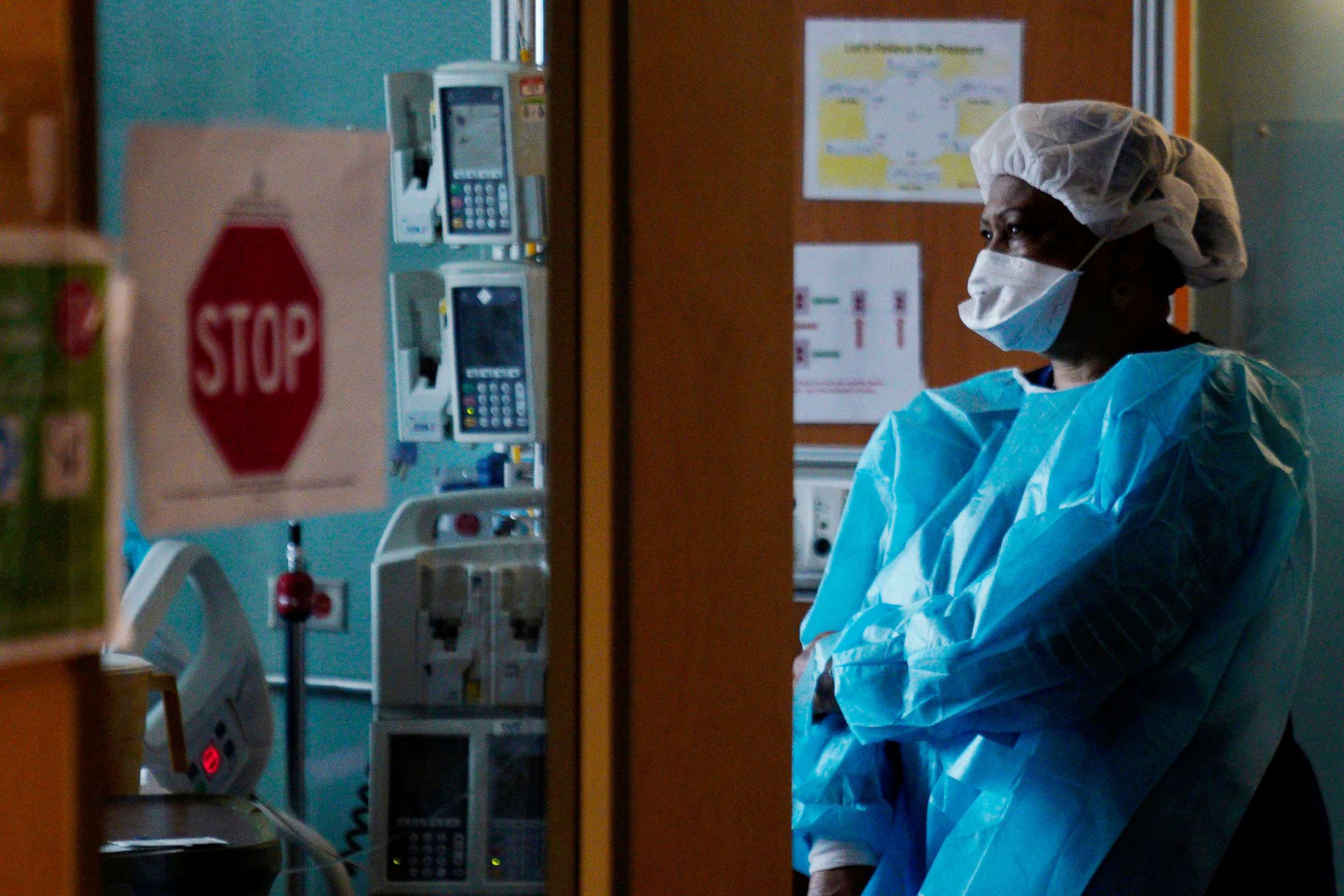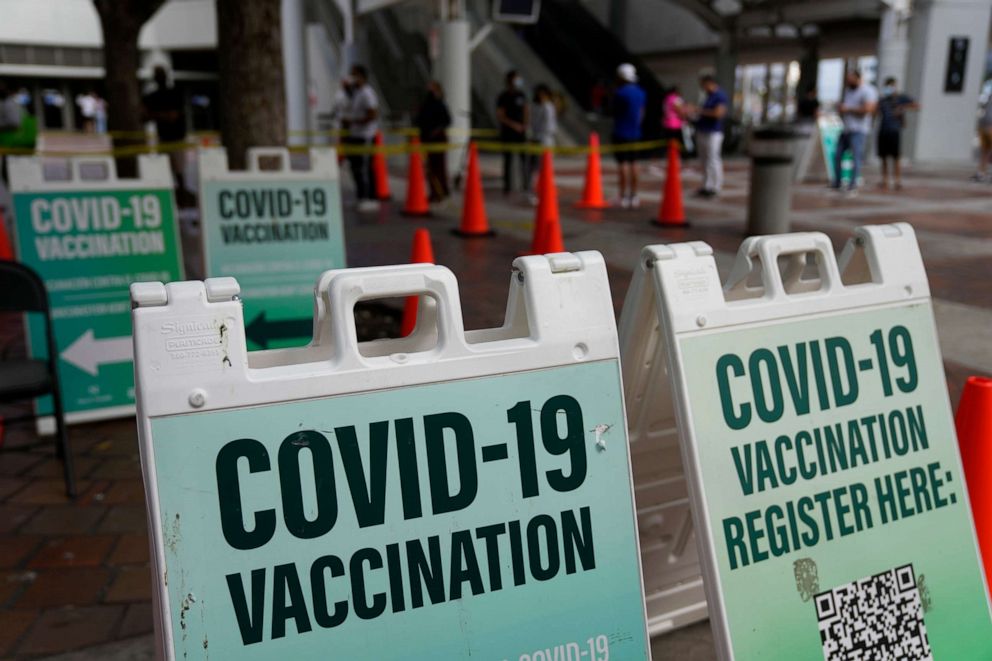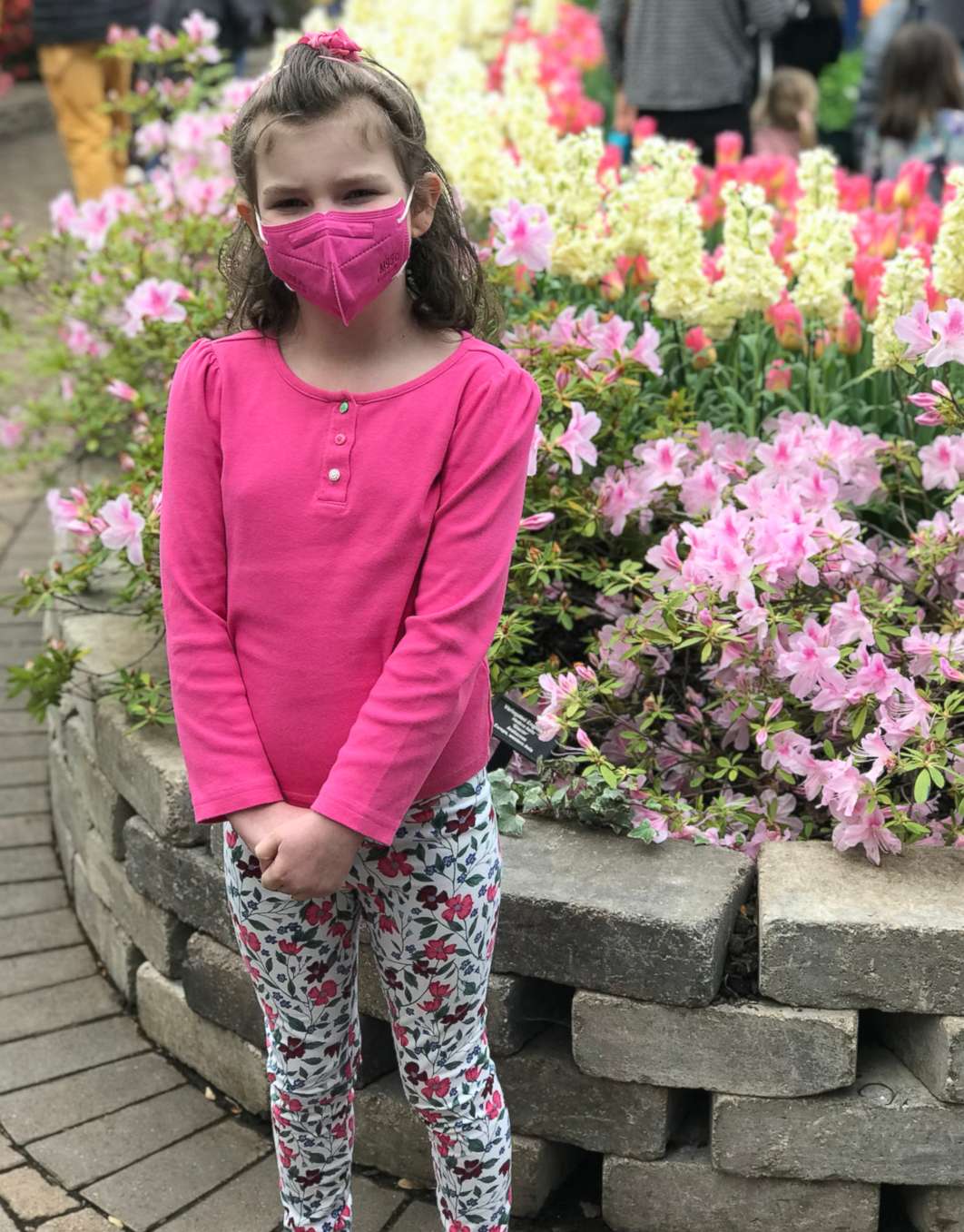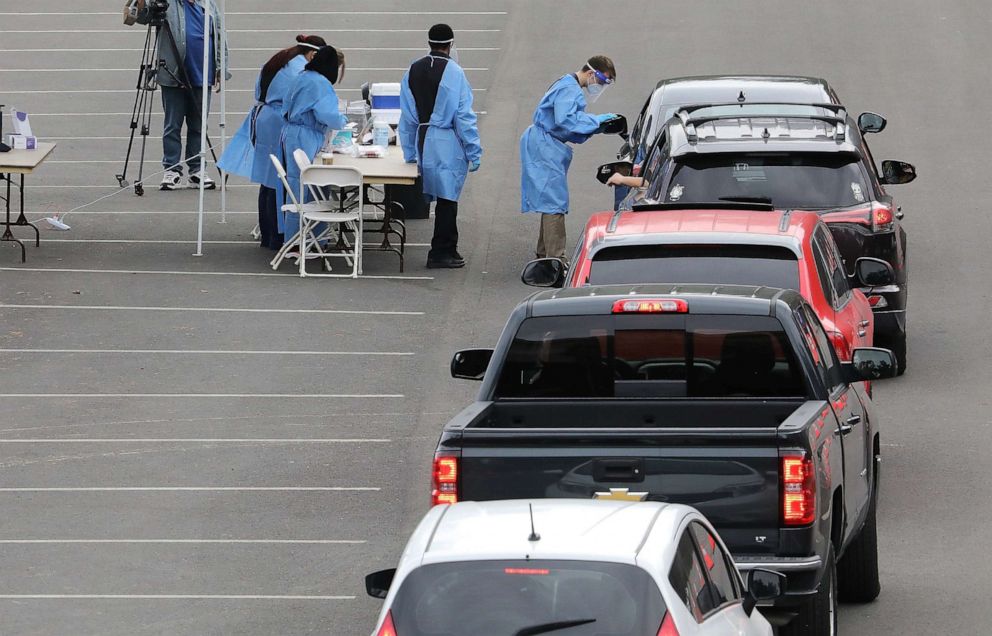As COVID-19 cases rise, disability advocates say CDC isn't doing enough
Meetings with the CDC have been devastating to watch, one advocate said.
After the omicron wave of COVID-19 receded earlier this winter, states and cities across the country moved quickly to ease mitigation measures, leaving many officials hopeful that the virus would soon be in the rear-view mirror, ahead of the looming midterm elections in November.
Much of the public rejoiced when the Centers for Disease Control and Prevention announced it would update its guidance for face coverings, giving the vast majority of Americans the green light to ditch masks indoors, if they lived in an area of low or medium risk.
However, for some high-risk populations, like the 7 million Americans living with weakened immune systems from cancer treatment, transplants or immune deficiencies, a return to pre-pandemic normalcy is still not on the horizon. The CDC's new guidance came with a caveat for the immunocompromised; the agency is still recommending that those at increased risk keep face coverings on.
With concert halls at full capacity again, largely maskless classrooms and social distancing stickers no longer visible in shopping outlets, many members of the immunocompromised and disabled communities are now appealing directly to the CDC and other federal health agencies in an effort to voice their frustrations.
“The fact that we have to just say over and over again, that our lives are worth saving — it's really soul crushing,” Maria Town, president and CEO of the American Association of People with Disabilities, told ABC News.

Moderately or severely immunocompromised people, or individuals who have a weakened immune system, are at increased risk of severe COVID-19 illness and death, according to the CDC.
As concerns over a new COVID-19 resurgence grow, advocates like Town have been pushing back on the administration’s decision to roll back recommended restrictions and are urging officials to reconsider implementing restrictions such as masking.
“There's a constant questioning of what can we be doing differently, what can we be doing more of and after two years of having to defend our humanity, it becomes even harder to answer those questions,” Town said.
'Seen this pattern before'
Last month, the American Association of People with Disabilities, alongside a group of more than 100 disability organizations, penned a letter to CDC Director Dr. Rochelle Walensky, urging her to revise the agency's latest COVID-19 guidance on masking, in an effort to protect high-risk populations in the U.S.
Under the CDC's new risk levels, most Americans living in areas with low or medium community spread levels were no longer recommended to wear masks indoors. However, the agency suggests that under the medium risk level, high-risk Americans should consider consulting with their physicians over whether or not to wear a mask.
“We have seen this pattern before. When protections that are key to lowering transmission, such as universal masking, are removed too soon after a peak and before low transmission is demonstrably sustained, new variants emerge, causing cases to spike and putting the lives of all Americans – particularly disabled, chronically ill, immunocompromised, people of color, and older people – at greater risk once again,” the organizations wrote.
A month after the original letter from the disability organizations was sent, two representatives from the CDC, John Auerbach, director of intergovernmental and strategic affairs, and Dr. Karen Remley, director of the National Center on Birth Defects and Developmental Disabilities, responded to the coalition, on behalf of Walensky.
"Dr. Walensky and CDC commit to moving forward together with people in the disability community with regular engagements between senior leadership and disability groups," the representatives said in a letter, dated Apr. 7, that was shared with ABC News.
"We know this pandemic has been particularly challenging for those who are at increased risk' of severe illness due to advanced age, certain disabilities, immune state, chronic medical conditions, or for other reasons... and it is important that we recognize this is not a small group among us — tens of millions of people are at an increased risk of getting severely ill if infected with the virus that causes COVID-19."
Even if CDC community transmission levels remain low, Auerbach and Remley noted that people can choose to wear masks based on "personal preference" or "level of risk."

Further, they said that public health officials, including schools, should take into account all community members when considering whether to "strengthen or add layered prevention strategies, not only for effective disease control, but also to protect those persons at greatest risk for severe illness or death."
The letters come amid a multitude of meetings between a coalition of disability advocacy organizations, and several representatives from the CDC, Health and Human Services as well as the White House.
Although members of the coalition said they are glad to be in more regular communication with the agencies, there is growing frustration among advocates, who believe that the CDC, in particular, is not fully doing its part to protect immunocompromised and vulnerable Americans.
The CDC, as a federal agency, does not have the authority to issue federal mandates for masking requirements or other mitigation measures outside a federal context, such as in an airport or public transportation setting. Although states and localities are responsible for setting their own public health guidelines, many follow the CDC's lead in what requirements should be set to keep the public safe and COVID-19 under control.
“We have seen some kind of movement as a result, but not nearly to the extent that we would have liked,” Town explained.
Meetings with the CDC have been “infuriating”, “emotional” and “devastating” to watch, a coalition member who has participated in meetings, and did not wish to be identified, told ABC News.
The CDC told ABC News in a statement that the agency is actively working with a number of disability organizations, officials on the federal, state, local, level and community-based organizations to help "people with disabilities access information, vaccination, and prevention resources" in an effort to protect against the deadly impacts of the virus.
"CDC has made it a priority to engage in dialogue with disability advocates to hear their concerns and identify areas where we can enhance protection for people with disabilities who are at higher risk of severe COVID-19 outcomes," a representative said. "We are committed to continuing the dialogue and addressing the systematic inequities that effect the health and wellbeing of millions of Americans that have been exacerbated during the pandemic."
‘Fighting for crumbs’
When President Joe Biden took office last year, Matthew Cortland, a disability rights advocate, was hopeful that although the pandemic was certainly not over, there might truly be a light at the end of the tunnel with COVID-19.
“I was hopeful that they would be much more willing to pursue and implement policies that really demonstrated a commitment to valuing the lives of chronically ill, disabled, and immunocompromised people. Unfortunately, that wasn't really the case,” Cortland said.
When asked by ABC News to identify some of the work the Biden administration has done to protect the lives of disabled and immunocompromised Americans since the President took office, the White House pointed to its COVID-19 preparedness plan, which they stress addresses the “needs of individuals with disabilities and older adults”, prioritizes “protections for individuals who are immunocompromised,” and accelerates “efforts to detect, prevent, and treat long COVID.”

Cortland lives with Crohn's disease, a form of inflammatory bowel disease, and takes immunosuppressant drugs. He said has been dismayed by the CDC's recent change in masking guidance.
He and other advocates have been pushing the CDC and other agencies to consider addressing disability bias in health care, ensure that people with disabilities—and other communities disproportionately impacted by COVID-19 — are not only at the center of CDC COVID-19 guidance, but also have increased access to high-quality masks, testing, vaccines, therapeutics, information and collect and report disability data for COVID-19.
“It feels like we are fighting for crumbs,” Cortland said. “The thing is the threat is so grave, and so pervasive and extends over the entire country that we have to fight for these crumbs, because these problems are going to keep some number of people alive.”
Thanks to key treatments and vaccines, a representative from the CDC told ABC News that the risk of becoming severely ill is now much lower for many people in the U.S. However, the agency noted that there are still people who are at high risk of falling ill from COVID-19.
"For many people in the U.S., the risk for severe illness, hospitalization, and death from COVID-19 is now much lower. Vaccination and testing levels are high, treatments are more advanced and available, and the population has increased immunity through vaccination or previous infection," the CDC representative said. "But some people are still at higher risk for serious effects of COVID-19 – this includes people who are immunocompromised, have underlying health conditions, have disabilities, or are older. People at higher risk, and the whole community, can be safe only when we all protect each other."
Some experts say that when COVID-19 ultimately does transition from pandemic to endemic, people will need to start treating it like other diseases.
“We should be having a conversation about when the right time is for masks to come off — and I think members of the immunocompromised community should have a voice in that conversation,” Dr. David Dowdy, an epidemiologist at the Johns Hopkins Bloomberg School of Public Health. “But I think we should be considering what is an appropriate threshold, not keeping mask mandates in effect forever.”
Although masks are still mandated in certain spaces such as on public transportation, some health experts have also voiced their concern over the rapid removal of COVID-19 restrictions, stressing that Americans must remember to take into account the health and wellbeing of others around them, even if they are tired of mask use and social distancing.
“I absolutely understand the urge and people wanting to get back to that 2019 style of living, but one big concern that a lot of colleagues and I have talked about was that we did it too quickly,” Dr. Alok Patel, a physician at Stanford Children's Health and ABC News contributor. “When we use the phrase the 'new normal,' we need to remind ourselves that that means something different for different people out there. So, we're reopening without a clear plan in place for those who are still high risk, including those who are immunocompromised.”
Deadly realities
For some Americans, the consequences of these decisions surrounding policies hit very close to home.
Leslie Cummings of Naperville, Illinois, has been vocalizing concerns after the Joint Committee on Administrative Rules in Illinois, voted 9-0 to suspend the emergency mask rules in schools.
Her 8-year-old daughter, Claudette, who is immunocompromised, was looking forward to returning to school following her vaccination series, but following the onset of omicron and her district’s decision to end mask requirements, those plans have been put on hold.
Despite the decision from the bipartisan committee, at the time, Illinois Gov. J.B. Pritzker continued to urge all schools and parents to keep wearing masks in an effort to "keep everyone in their schools and communities safe."
“If she gets COVID-19... it could kill her,” Cummings told ABC News. “She is very susceptible to anything having to do with her heart, lungs or liver.”
Claudette has hypoplastic left heart syndrome, resulting in multiple open-heart surgeries and procedures and the prescription of numerous medications.

“Even though she's vaccinated, at least 45% of the kids in our school district are not vaccinated. Unvaccinated kids are more likely to get COVID and more likely to spread it, and that's another big concern,” Cummings explained. “If there were more vaccinated kids, more kids wearing masks, it would be different, but we're just not there."
Despite continuously speaking out about her concerns over the potential impact of the virus on her daughter’s health, Cummings has been struck by what she perceives as lack of caring from the public.
“I've had a real awakening about this country in the last two years, about how selfish some people are. It's been very sad for me, and it also makes me very angry that people just don't seem to care,” Cummings said. “They don't care that you know, that there's all these people out here that are their aunts, their brothers, their sisters, their cousins, their neighbors, their community members, the elderly, and they just don't seem to care.”
1 in 4 American adults is living with disabilities
Earlier this year, an analysis from the Center for American Progress found that there were an estimated additional 1.2 million people living with disabilities (1 in 4 Americans total), many of whom face inadequate healthcare resources, as well as higher rates of unemployment, and over-representation in low-wage positions.
The U.S. Bureau of Labor Statistics currently defines a person with a disability as someone who has one of a list of disabilities, including blindness, deafness, or someone who has difficulty conducting daily tasks because of a physical, mental, or emotional condition.
One of the concerns was making sure that employers "accommodate newly disabled workers to comply with civil rights laws, including the Americans with Disabilities Act.” In the first month, the definition of "at-risk" was expanded, allowing for greater accommodations for the vulnerable members of the population.
“The definition of who counts as high risk was extremely narrow, and that has big implications for disabled people,” Town explained. “If you are someone who is at high risk of getting COVID-19, but your disability is not named in the CDC is definition, and you're requesting an accommodation to continue working from home, or to receive services via telehealth, your employer is likely to look at that definition and determine whether or not you're eligible.”

To further mitigate the risk of COVID-19 infection among vulnerable populations, Cortland would like to see people wearing highly protective masks, such as KN-95s or N-95s, and for the country to invest in better ventilation and filtration systems for schools and workplaces, so that immunocompromised individuals will feel safer participating.
Advocates have also asked for greater guidance on when different members of the disabled and high-risk community should get vaccinated and boosted, as well as funding for at-home vaccination programs.
The CDC pointed ABC News to some of the recent "disability work" it has done, including funding to embed disability specialists in 28 state, territorial, and local health department across the U.S., a CDC COVID-19 Toolkit for People with Disabilities, which includes guidance and tools to help high-risk people make informed decisions about protecting their health, and an online central repository of COVID-19 resources for health departments and organizations.
"While progress has been made to protect people with disabilities during the COVID-19 pandemic, more work is needed," a representative for the agency said.
The CDC said it is working to help reduce health disparities related to COVID-19 among people with disabilities, with initiatives including providing accessible materials and culturally relevant messages for people with disabilities, and addressing and expanding COVID-19 vaccine access and confidence among people with disabilities.
Even with some positive changes, advocates say there is still work to do. Moving forward, it will be critical to address the intersectional needs of all disabled, immunocompromised, chronically ill, and high-risk Americans to fairly and equitably enter into a new phase of the pandemic.
“I don't have a choice but to keep fighting for these problems,” Cortland said. “Keeping some number of people alive who would otherwise die is better than not, but is it enough? Absolutely not.”
ABC News' Nam Cho contributed to this report.




